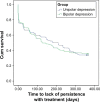Time to lack of persistence with pharmacological treatment among patients with current depressive episodes: a natural study with 1-year follow-up
- PMID: 27822021
- PMCID: PMC5096725
- DOI: 10.2147/PPA.S109941
Time to lack of persistence with pharmacological treatment among patients with current depressive episodes: a natural study with 1-year follow-up
Abstract
Introduction: Medication nonadherence remains a big challenge for depressive patients. This study aims to assess and compare the medication persistence between unipolar depression (UD) and bipolar depression (BD).
Methods: A total of 146 UD and 187 BD patients were recruited at their first index prescription. Time to lack of persistence with pharmacological treatment (defined as a gap of at least 60 days without taking any medication) was calculated, and clinical characteristics were collected. Final diagnosis was made at the end of 1-year follow-up.
Results: A total of 101 (69.2%) UD and 126 (67.4%) BD patients discontinued the treatment, with a median duration of 36 days and 27 days, respectively. No significant difference was found between UD and BD in terms of time to lack of persistence with pharmacological treatment. The highest discontinuation rate (>40%) occurred in the first 3 months for both groups of patients. For UD patients, those with a higher risk of suicide (odds ratio [OR] =0.696, P=0.035) or comorbidity of any anxiety disorder (OR =0.159, P<0.001) were less likely to prematurely drop out (drop out within the first 3 months), while those with onset in the summer (OR =4.702, P=0.049) or autumn (OR =7.690, P=0.012) were more likely to prematurely drop out than those with onset in the spring (OR =0.159, P<0.001). For BD patients, being female (OR =2.250, P=0.012) and having a history of spontaneous remission or switch to hypomania (OR =2.470, P=0.004) were risk factors for premature drop out, while hospitalization (OR =0.304, P=0.023) and misdiagnosis as UD (OR =0.283, P<0.001) at the first index prescription were protective factors.
Limitation: Conservative definition of nonadherence, low representativeness of sample.
Conclusion: Treatment discontinuation was frequently seen in patients with UD or BD, especially in the first 3 months of treatment. In spite of the similar pattern of medication persistence, UD and BD differ from each other in predictors of premature drop out.
Keywords: bipolar depression; medication adherence; unipolar depression.
Conflict of interest statement
The authors report no conflicts of interest in this work.
Figures
Similar articles
-
Patterns of persistence with pharmacological treatment among patients with current depressive episode and their impact on long-term outcome: a naturalistic study with 5-year follow-up.Patient Prefer Adherence. 2018 May 3;12:681-693. doi: 10.2147/PPA.S160767. eCollection 2018. Patient Prefer Adherence. 2018. PMID: 29765205 Free PMC article.
-
Can P300 aid in the differential diagnosis of unipolar disorder versus bipolar disorder depression? A meta-analysis of comparative studies.J Affect Disord. 2019 Feb 15;245:219-227. doi: 10.1016/j.jad.2018.11.010. Epub 2018 Nov 4. J Affect Disord. 2019. PMID: 30412774
-
Patterns and predictors of conversion to bipolar disorder in 91 587 individuals diagnosed with unipolar depression.Acta Psychiatr Scand. 2018 May;137(5):422-432. doi: 10.1111/acps.12869. Epub 2018 Mar 2. Acta Psychiatr Scand. 2018. PMID: 29498031
-
ECNP consensus meeting. Bipolar depression. Nice, March 2007.Eur Neuropsychopharmacol. 2008 Jul;18(7):535-49. doi: 10.1016/j.euroneuro.2008.03.003. Epub 2008 May 23. Eur Neuropsychopharmacol. 2008. PMID: 18501566 Review.
-
Differentiating between bipolar and unipolar depression in functional and structural MRI studies.Prog Neuropsychopharmacol Biol Psychiatry. 2019 Apr 20;91:20-27. doi: 10.1016/j.pnpbp.2018.03.022. Epub 2018 Mar 28. Prog Neuropsychopharmacol Biol Psychiatry. 2019. PMID: 29601896 Review.
Cited by
-
Clinical Predictors of Engagement in Teleintegrated Care and Telereferral Care for Complex Psychiatric Disorders in Primary Care: a Randomized Trial.J Gen Intern Med. 2022 Oct;37(13):3361-3367. doi: 10.1007/s11606-021-07343-x. Epub 2022 Feb 2. J Gen Intern Med. 2022. PMID: 35106719 Free PMC article. Clinical Trial.
-
Case Report: Paliperidone Palmitate in the Management of Bipolar I Disorder With Non-compliance.Front Psychiatry. 2021 Jan 8;11:529672. doi: 10.3389/fpsyt.2020.529672. eCollection 2020. Front Psychiatry. 2021. PMID: 33488408 Free PMC article.
-
Patterns of persistence with pharmacological treatment among patients with current depressive episode and their impact on long-term outcome: a naturalistic study with 5-year follow-up.Patient Prefer Adherence. 2018 May 3;12:681-693. doi: 10.2147/PPA.S160767. eCollection 2018. Patient Prefer Adherence. 2018. PMID: 29765205 Free PMC article.
References
-
- Hyler SE. APA online CME practice guideline for the treatment of patients with major depressive disorder. J Psychiatr Pract. 2002;8(5):315–319. - PubMed
-
- Yatham LN, Kennedy SH, Parikh SV, et al. Canadian Network for Mood and Anxiety Treatments (CANMAT) and International Society for Bipolar Disorders (ISBD) collaborative update of CANMAT guidelines for the management of patients with bipolar disorder: update 2013. Bipolar Disord. 2013;15(1):1–44. - PubMed
-
- Conti V, Lora A, Cipriani A, Fortino I, Merlino L, Barbui C. Persistence with pharmacological treatment in the specialist mental healthcare of patients with severe mental disorders. Eur J Clin Pharmacol. 2012;68(12):1647–1655. - PubMed
-
- Tanno S, Ohhira M, Tsuchiya Y, Takeuchi T, Tanno S, Okumura T. Frequent early discontinuation of SSRI prescribed by primary care physicians in young males in Japan. Intern Med. 2009;48(15):1263–1266. - PubMed
-
- Shigemura J, Ogawa T, Yoshino A, Sato Y, Nomura S. Predictors of antidepressant adherence: results of a Japanese Internet-based survey. Psychiatry Clin Neurosci. 2010;64(2):179–186. - PubMed
LinkOut - more resources
Full Text Sources
Other Literature Sources
Miscellaneous


